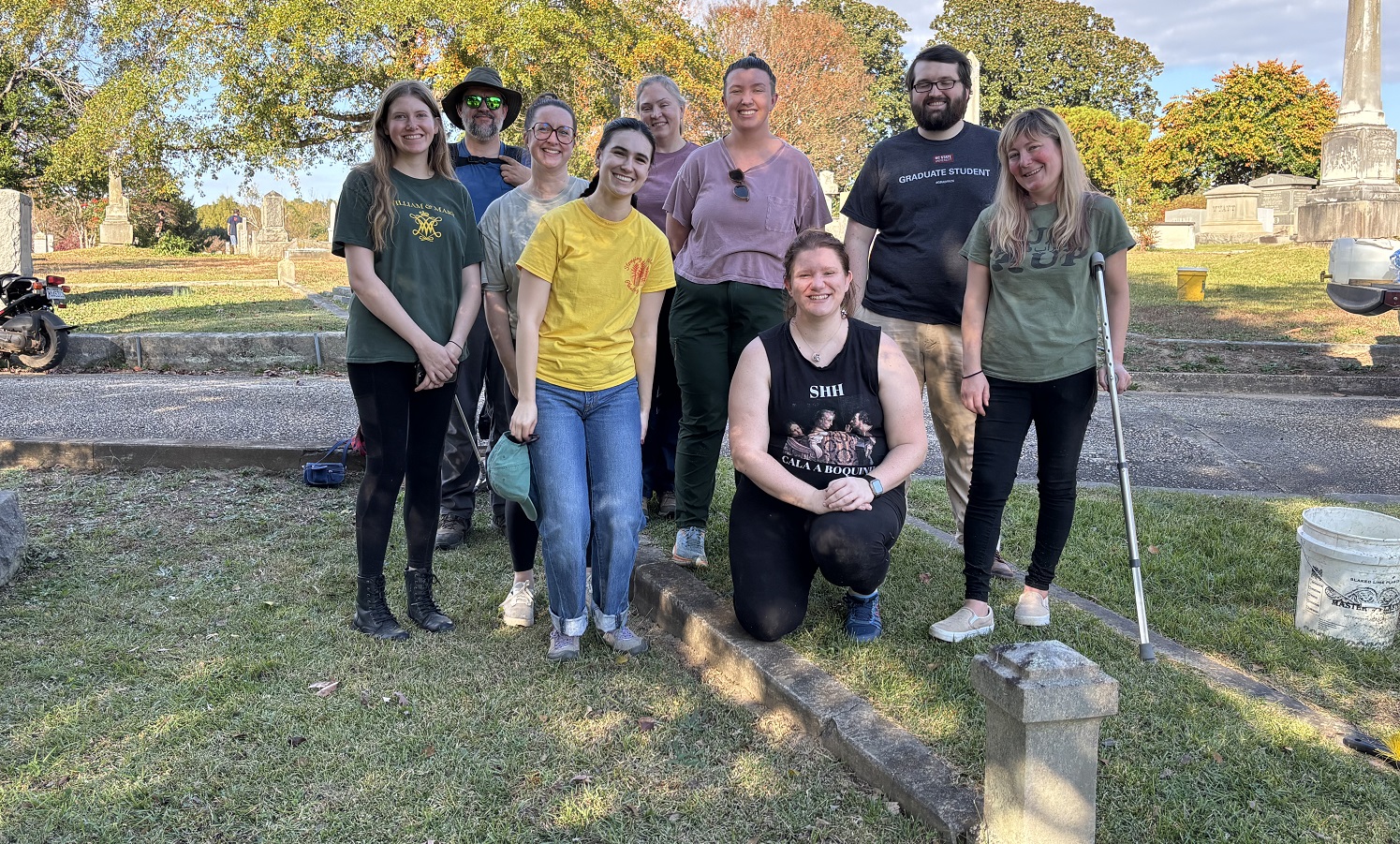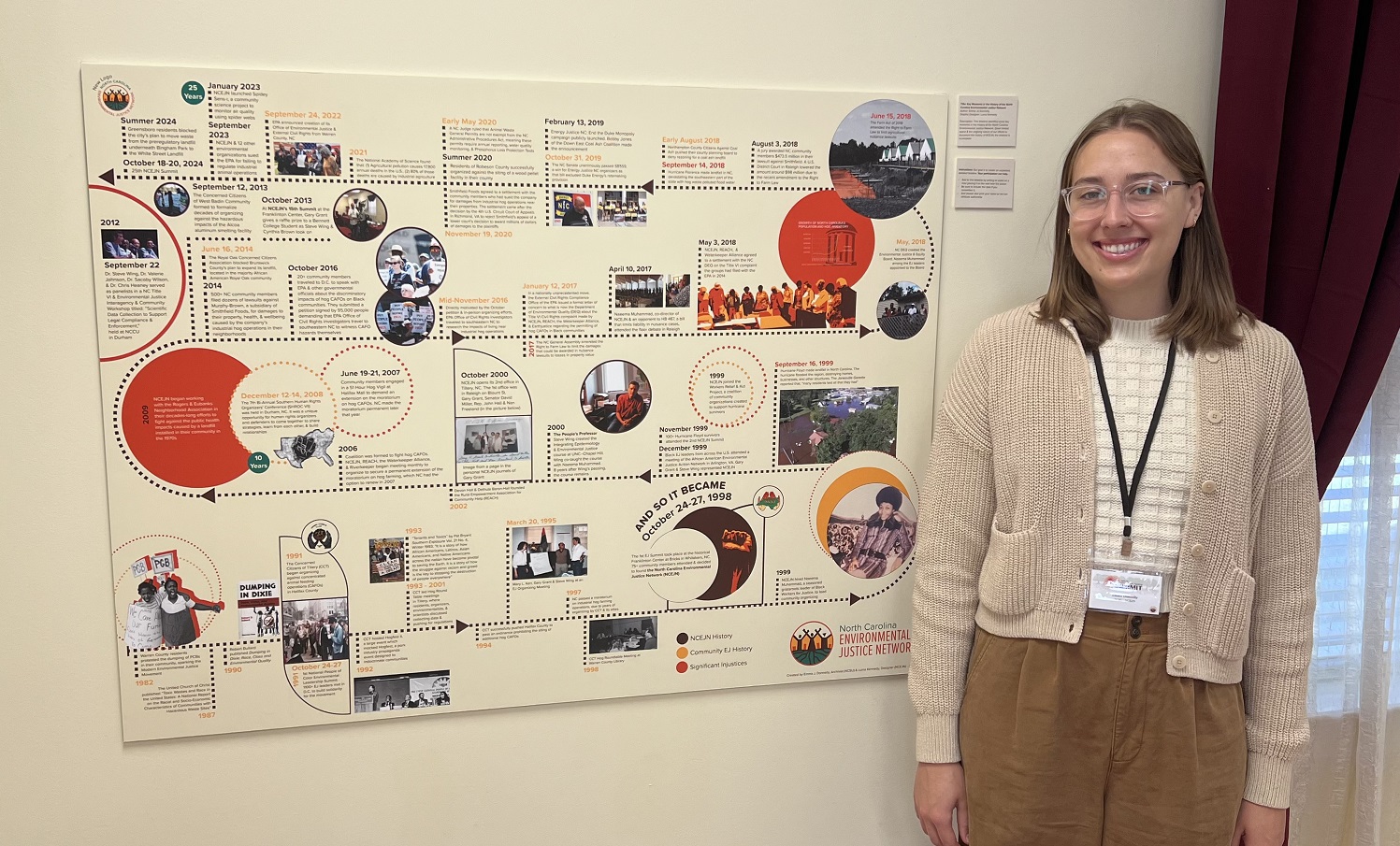Class Trip Explores People’s History of Civil Rights
Editor’s Note: This post is from Katherine Mellen Charron, an associate professor of history at NC State.
On Sept. 19, 2017, a group of students sat in a van parked on the side of the road in front of the Coolmore Plantation in rural Edgecombe County. They listened as Clarence Powell, a 91-year-old African American World War II veteran, recounted the escape of his great-grandfather, Albert Powell, from that sprawling cotton farm during the Civil War. Making his way to Union lines, he enlisted in the Union Army and fought for his people’s freedom. But Albert Powell never saw his family again. When he returned from the war, he discovered they, too, had fled seeking freedom.
This is just one of many stories that NC State traditional and public history graduate students enrolled in an American History and Memory class heard that day from members of the Phoenix Historical Society (PHS), a grassroots organization established in 2001 to “recover, record and promote the unique history of Edgecombe County as experienced by its African American members.”
As a student recognized, PHS members serve as both “local historians” and “memory keepers” who “craft their own narratives…reflecting the ebb and flow of liberation politics rooted in specific social, political, cultural, and economic spaces.” Touring Rocky Mount, Tarboro and Princeville, the group gained invaluable insights into a local freedom struggle that has persisted for over 150 years.
One key event set the stage for much of what would follow. In 1871, the North Carolina legislature redrew the county lines of Nash and Edgecombe to dilute black voting and economic power. Yet Edgecombe also remained part of a state congressional district known as the “Black Second,” and its African American residents did not relinquish any hard won gains without a fight. In 1876, Edgecombe voters elected a black majority to the county board of commissioners for the first time. A year later, the General Assembly responded by passing a law that stripped all voters of the right to elect their county commissioners and transferred that power to justices of the peace that it had appointed.

One of six State Highway Historical Markers erected by the Phoenix Historical Society in Edgecombe County.
The pursuit of political and economic justice nevertheless continued. Beginning in 1886, black farm workers organized 11 local assemblies of the Knights of Labor (KOL). These ardent freedom fighters launched a strike to improve working conditions on nearby cotton plantations, helped elect Henry P. Cheatham to the U.S. Congress, and secured a second term for KOL leader Frank M. Hines as county register of deeds.
In the mid-1890s, KOL members also joined the interracial “Fusion” coalition of Republican and Populist voters that triumphed in the 1894 and 1896 statewide elections. According to the PHS, “the 1896 election in North Carolina was hailed as the most democratic election in the South and 87 percent of black voters participated.” In Edgecombe County, voters sent African American attorney George Henry White to the U.S. Congress.
Success provoked a harsh backlash. During the 1898 white supremacy campaigns, white conservatives used violence and voting fraud to win back control of the state government, and then disfranchised African American men in 1900. In his last congressional speech in 1901, White provided the quote from which the PHS takes its name: “This, Mr. Chairman, may be the Negroes temporary farewell to the American Congress, but let me say, Phoenix-like, he will rise up some day and come again.” Ninety-one years would pass before Eva Clayton became the second African American in North Carolina to win election to the U.S. House of Representatives.
It took less time for another robust labor movement to emerge. The class tour included the Imperial tobacco complex, Rocky Mount Mills, and the China American plant, prominent sites of a 1946 union organizing drive by over 10,000 black tobacco workers, 75% of whom were women. Part of the Congress of Industrial Organization’s “Operation Dixie,” this campaign brought basic workplace rights to the area, and not a single one of the 27 elections held resulted in a union defeat.
“We wanted some freedom,” former union member Athenia Moses recalled in 2007. The union-led voter registration drives that followed proved equally important. “The tobacco leaf house workers unions,” the PHS notes, “formed an organizational back bone for civil rights in the Eastern North Carolina black community” into the 1950s, 60s, and 70s.
Other trip highlights included talking with Ruth Bullard and residents of the “Around the Y” community, birthplace of jazz great Thelonious Monk, and learning about the landmark 1978 strike of city sanitation workers from strike leader Leonard Giles.

Students listen to Leonard Giles, leader of the 1978 landmark strike by Rocky Mount city sanitation workers, in the parking lot behind the former Booker T. Washington High School. Mr. Clarence Powell, who shared the story of his great-grandfather’s fighting in the Civil War stands on the far left.
In Tarboro, the group visited the Quigless Clinic, a hospital established in 1946 by Dr. Milton D. Quigless Sr. that he ran until his death in 1997. They sat in the sanctuary of St. Stephens Missionary Baptist Church as a current member read an article detailing a KOL meeting that occurred there in 1889, and they stood in front of George Henry White’s house as Roderick Stith recited his farewell speech to Congress. Then they headed across the Tar River to see Princeville, the oldest incorporated African American town in the U.S. still in the process of recovering from Hurricane Matthew last October.
“It’s important to get your interpretation out in public and not just in history books,” PHS Vice President Jim Wrenn told the graduate students.
To date, the PHS has conducted all research necessary to erect six State Highway Historical Markers commemorating events in the 19th and 20th centuries. Due to PHS efforts, George Henry White’s portrait now hangs in the Tarboro Post Office, which has been renamed in his honor, and another hangs in the Edgecombe County Superior Court. The PHS has also designed a walking tour and hosts programs that continue to educate the public about this momentous history.
Reflecting on the tour, another student observed: “Ultimately, this field trip provided me with a stark reminder of the weight of public history and historical inquiry; stories about the past do not simply recall a distant era but still have recurring and overlapping meanings and uses” in the present.
- Categories:


